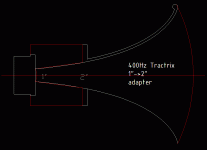Gentleman,
In this thread I will post my new project 400Hz Tractrix with Monacor DT400 and high efficiency woofer like SP15A/350Neo. It is meant to reach 104dB/1W/1m and +/- 0,5dB linearity in 600-18000Hz without eq.
One question for more experienced - my horn has 2" throat so that 1"->2" adapter is necessary. I've drawn such adapter having Tractrix curve from Excel and what I see is nearly a straight expansion. No more than 1,5mm difference (see picture). Is it really important having precise curvature if such a difference is so small?
In this thread I will post my new project 400Hz Tractrix with Monacor DT400 and high efficiency woofer like SP15A/350Neo. It is meant to reach 104dB/1W/1m and +/- 0,5dB linearity in 600-18000Hz without eq.
One question for more experienced - my horn has 2" throat so that 1"->2" adapter is necessary. I've drawn such adapter having Tractrix curve from Excel and what I see is nearly a straight expansion. No more than 1,5mm difference (see picture). Is it really important having precise curvature if such a difference is so small?
Attachments
Tractrix horn
Hi jzagaja, You started a very interesting thread. Could you elaborate how your finished speaker sounded ? The Tractrix 110 can be used with a driver up to 4.5" or 115 mm - which units are compatible ? Is it possible to cut the mouth of the Tractrix to accomodate a larger CD ? Tractrix horns are quite expensive. How does this translate in the acoustic quality ?
Hi jzagaja, You started a very interesting thread. Could you elaborate how your finished speaker sounded ? The Tractrix 110 can be used with a driver up to 4.5" or 115 mm - which units are compatible ? Is it possible to cut the mouth of the Tractrix to accomodate a larger CD ? Tractrix horns are quite expensive. How does this translate in the acoustic quality ?
If it is a construction issue, why not make a cone then line it with some filler and sand it back?
Adapters All
Matching slopes and diameters at the connection points is at issue.
The curvature between them is relatively unimportant so long as there are no discontinuities introduced at either of these two points.
To determine adapter profile and length, you solve two simultaneous equations incorporating the two tangent points and associated radii.
The solution formula may not be that of the tractrix (derivative). If so, the derivative of Salmon's horn formula can be used instead.
Note that slope m = tan(a) = dy/dx = f'(x)
I would use adapters to mount all compression drivers to your horn design.
These would be tailored the match various compression driver exit slopes and diameters to a common horn body of your design.
Regards,
WHG
Gentleman,
In this thread I will post my new project 400Hz Tractrix with Monacor DT400 and high efficiency woofer like SP15A/350Neo. It is meant to reach 104dB/1W/1m and +/- 0,5dB linearity in 600-18000Hz without eq.
One question for more experienced - my horn has 2" throat so that 1"->2" adapter is necessary. I've drawn such adapter having Tractrix curve from Excel and what I see is nearly a straight expansion. No more than 1,5mm difference (see picture). Is it really important having precise curvature if such a difference is so small?
Matching slopes and diameters at the connection points is at issue.
The curvature between them is relatively unimportant so long as there are no discontinuities introduced at either of these two points.
To determine adapter profile and length, you solve two simultaneous equations incorporating the two tangent points and associated radii.
The solution formula may not be that of the tractrix (derivative). If so, the derivative of Salmon's horn formula can be used instead.
Note that slope m = tan(a) = dy/dx = f'(x)
I would use adapters to mount all compression drivers to your horn design.
These would be tailored the match various compression driver exit slopes and diameters to a common horn body of your design.
Regards,
WHG
- Status
- Not open for further replies.
